How Can We Help?
This is the current list of the national symbols of China. The People's Republic of China (PRC) controls all of mainland China, while the Republic of China (ROC) controls Taiwan and nearby islands. See National symbols of Taiwan. Both countries used to claim to be the legitimate government of all of China, with Taiwan informally dropping territorial claims in the early nineties.
Symbols of the People’s Republic of China
| Symbol | Image | Description | |
|---|---|---|---|
| National flag | 
|
The national flag of the People's Republic of China was designed by Zeng Liansong. It has a red field charged with five golden stars in the canton. The color red represents the Chinese Communist Revolution, the four smaller stars represent the four social classes in Chinese society, and the largest star represents Chinese unity under the leadership of the Chinese Communist Party (CCP). One corner of each of the four smaller stars points towards the center of the bigger star, representing the principle that unity should go around the center. This flag is flown in the mainland, Hong Kong, and Macau. | |
| National emblem | 
|
The National Emblem of China includes the Tiananmen Gate, where Mao declared the foundation of the People's Republic of China, in a red circle. Above the Gate are five stars; the largest represents the CCP, while the four smaller stars represent the four social classes. The emblem's outer border contains sheaves of wheat and rice, representing Chinese agricultural workers. At the bottom center is a cog-wheel, representing Chinese industrial workers. The red ribbon represents the unification of the Chinese people. | |
| National anthem | The national anthem of China is the "March of the Volunteers". Its lyrics were composed by poet and playwright Tian Han and its music was composed by Nie Er. | ||
| Founder of the nation | Mao Zedong[1] | 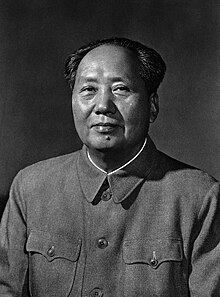
|
Mao Zedong (1893–1976) established the PRC on October 1, 1949, which remains a national holiday. His portrait is displayed on the entrance of Tiananmen Square. |
| Qin Shi-huang[2] | 
|
Qin Shi-huang (literally, "First Emperor of Qin") (259 BC - 210 BC) was the founder of the Qin dynasty and then, after the Qin conquered the other Warring States and unified all of China, the first emperor of a unified China.[3] He is widely considered to be the founder of China as a country. | |
| National currency | Renminbi[relevant?] | The renminbi is the official currency of the People's Republic of China. The yuan is its basic unit. | |
| National animal | Giant panda[4] | 
|
The national animal of China is the giant panda (Ailuropoda melanolueca), a bear native to south-central China. |
| Chinese dragon[5] | 
|
The Chinese dragon, or Loong, is one of four auspicious legendary creatures appearing in Chinese mythology and folklore. The dragon has many animal-like body parts, including wolf's head, stag's antlers, hare's eyes, bull's ears, serpent's torso, carp's squama, tiger's limbs and eagle's talons. [6] Theories claim that Loong was a combination of totems of many tribes created to unite them under one banner. | |
| National bird | Red-crowned crane |

|
The red-crowned crane or Manchurian crane (Grus japonensis) is a large East Asian crane and among the rarest cranes in the world. It is found in Siberia (eastern Russia), northeastern China, and the Mongol Daguur Strictly Protected Area in northeastern Mongolia. |
| Golden pheasant[7] (unofficial) [relevant?] | 
|
The golden pheasant (Chrysolophus pictus) is a game bird of the family Phasianidae. Although it is native to western China, feral populations have been established in the United Kingdom, Canada, the United States, Mexico, Colombia, Peru, Bolivia, Chile, Argentina, Uruguay, the Falkland Islands, Germany, Belgium, the Netherlands, France, Ireland, Australia and New Zealand. | |
| National fruit | Fuzzy kiwifruit[8] | 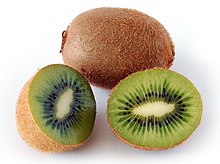
|
The fuzzy kiwifruit is the national fruit of China.[8] It has fuzzy, dull brown skin and tangy, bright green flesh. |
| Jujube[8] | 
|
The jujube (Ziziphus zizyphus) is the second national fruit of China.[8] It is an oval drupe 1.5-3 centimeters deep; it resembles a date and has a single hard stone like an olive. | |
| National tree | Ginkgo[9] | 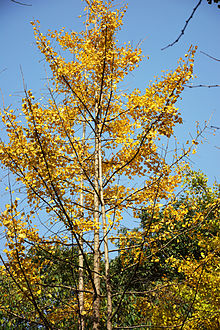
|
Ginkgo (Ginkgo biloba) is the only living species in the division Ginkgophyta, all others being extinct. |
| National Instrument | Guqin[10] | 
|
The guqin (古琴) is a plucked seven-string Chinese musical instrument. It has been played since ancient times, and has traditionally been favoured by scholars and literati as an instrument of great subtlety and refinement.[11] |
| National sport | Table tennis[12] | Table tennis has been declared by Chairman Mao as a Chinese national sport.[13] | |
| National dish | Peking duck[14] | 
|
China's globally recognized national dish is the Peking duck.[15] |
| National Poet | Li Bai[16][17][18] | 
|
Li Bai, also known as Li Bo, courtesy name Taibai, art name Qinglian Jushi, was a Chinese poet, acclaimed from his own time to the present as a brilliant and romantic figure who took traditional poetic forms to new heights. |
| National Philosopher | Confucius[19] | 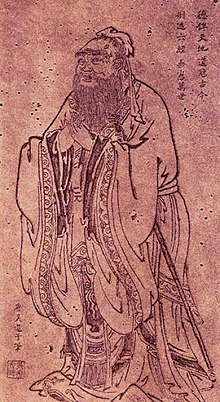
|
Confucius was a Chinese philosopher and politician of the Spring and Autumn period who is traditionally considered the paragon of Chinese sages. Confucius's teachings and philosophy underpin East Asian culture and society, remaining influential across China and East Asia to this day. |
| National Calendar | Chinese calendar[20] | The traditional Chinese calendar was developed between 771 and 476 BCE, during the Spring and Autumn period of the Eastern Zhou dynasty. | |
| National Clothing | Cheongsam[21] | 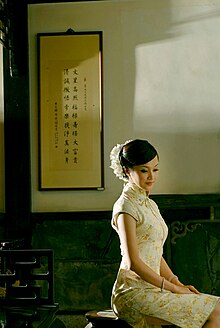
|
Cheongsam and sometimes referred as the mandarin gown, is a Chinese dress worn by women which takes inspiration from the qizhuang, the ethnic clothing of the Manchu people.[22] |
| Hanfu[23] | 
|
Hanfu is the traditional styles of clothing worn by the Han Chinese.[23] | |
| National Drink | Baijiu[24][25] | 
|
Baijiu is a Chinese colourless liquor typically coming in between 35% and 60% alcohol by volume (ABV).[26][27] |
| National flower | Peony[28] | 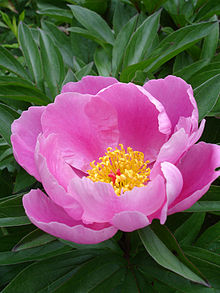
|
Paeonia lactiflora (Chinese peony, Chinese herbaceous peony, or common garden peony) is a species of herbaceous perennial flowering plant in the family Paeoniaceae, native to central and eastern Asia from eastern Tibet across northern China to eastern Siberia. |
See also
References
- ^ "Father of The Nation of China: Symbols of China". WhatsAnswer. Retrieved 26 June 2024.
- ^ "Qin Shi Huang". Britannica. Retrieved 26 June 2024.
- ^ Duiker, William J. & al. World History: Volume I: To 1800, 5th ed., p. 78. Thomson Higher Education Publishing, 2006. ISBN 0-495-05053-9.
- ^ "What is the national animal of China?". BBC Wildlife. Retrieved 26 June 2024.
- ^ "What Are The National Animals Of China?". WorldAtlas.com. Retrieved 26 June 2024.
- ^ according to a famous traditional chinese incunabulum Compendium of Materia Medica, aka《本草纲目》
- ^ Yunqi, Li (5 February 2019). "Wildlife of China: The golden pheasant". China Global Television Network. Retrieved 26 June 2024.
- ^ a b c d "National Fruit of China: Symbols of China". WhatsAnswer. Retrieved 26 June 2024.
- ^ "National Tree of China: Symbols of China". WhatsAnswer. Retrieved 26 June 2024.
- ^ Beijing Review, Issues 27-52. Beijing Review, original from the University of Michigan. 1981. p. 30.
- ^ "The Qin". Heilbrunn Timeline of Art History of the Metropolitan Museum of Art. Retrieved 26 June 2024.
Endowed with cosmological and metaphysical significance and empowered to communicate the deepest feelings, the qin is the most prestigious of China's instruments.
- ^ "National Sports". Top End Sports. Retrieved 26 June 2024.
- ^ Gao, Helen (8 August 2012). "China, Still the World Champ, Is Falling Out of Love With Table Tennis". The Atlantic. Retrieved 26 June 2024.
- ^ Bai, Mary (27 September 2011). "Peking Roast Duck, China's National Food". CITS Group Corporation. Archived from the original on 12 March 2014.
- ^ "What Is The National Dish Of China?". WorldAtlas.com. Retrieved 26 June 2024.
- ^ Hao, Tianhu (2012). "Milton in Late-Qing China (1837-1911) and the Production of Cross-Cultural Knowledge". Milton Quarterly. 46 (2): 86–105. doi:10.1111/j.1094-348X.2012.00330.x. JSTOR 24463978.
- ^ "Poetic Genius, Sage of Poetry, Buddhist Poet and Poet-Ghost". en.chinaculture.org.
- ^ Ward, J. E. (2008). Li Bai: an Homage To. United Kingdom: Lulu.com.
- ^ Mark, Joshua J. (7 July 2020). "Confucianism". World History Encyclopedia. Retrieved 26 June 2024.
- ^ "Chinese calendar". Britannica. Retrieved 26 June 2024.
- ^ "Cheongsam and ao dai: Traditional costumes of China, Vietnam". China Global Television Network. 9 December 2023. Retrieved 26 June 2024.
- ^ Mack, Lauren (8 September 2019). "What Is a Qipao in Chinese Fashion?". thoughtco.com. Retrieved 26 June 2024.
- ^ a b "Top 5 Styles of Traditional Chinese Dress & Clothing". Newhanfu. Retrieved 26 June 2024.
- ^ Zheng, Xiao‐Wei, et al. "Daqu—A traditional Chinese liquor fermentation starter." Journal of the Institute of Brewing 117.1 (2011): 82–90.
- ^ Rong and Fa, Grandiose Survey of Chinese Alcoholic Drinks and Beverages, 2013, "Grandiose Survey of Chinese Alcoholic Drinks and Beverages". Archived from the original on 2014-07-29. Retrieved 2015-05-29.
- ^ "A Guide to Chinese Alcohol". Lost Laowai:China expat.
- ^ "The World's Most Consumed Alcohol Is One You Might Not Have Tried. But It's Coming to a Bar Near You". Time.
- ^ "Cheongsam and ao dai: Traditional costumes of China, Vietnam". China Global Television Network. 25 July 2019. Retrieved 26 June 2024.


Recent Comments